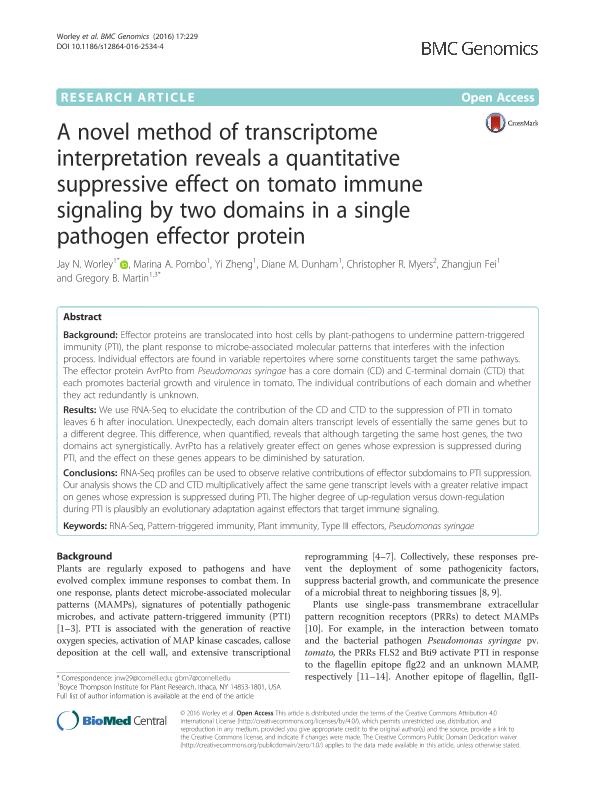Artículo
A novel method of transcriptome interpretation reveals a quantitative suppressive effect on tomato immune signaling by two domains in a single pathogen effector protein
Worley, Jay N.; Pombo, Marina Alejandra ; Zheng, Yi; Dunham, Diane M.; Myers, Christopher R.; Fei, Zhangjun; Martin, Gregory B.
; Zheng, Yi; Dunham, Diane M.; Myers, Christopher R.; Fei, Zhangjun; Martin, Gregory B.
 ; Zheng, Yi; Dunham, Diane M.; Myers, Christopher R.; Fei, Zhangjun; Martin, Gregory B.
; Zheng, Yi; Dunham, Diane M.; Myers, Christopher R.; Fei, Zhangjun; Martin, Gregory B.
Fecha de publicación:
03/2016
Editorial:
BioMed Central
Revista:
BMC Genomics
ISSN:
1471-2164
Idioma:
Inglés
Tipo de recurso:
Artículo publicado
Clasificación temática:
Resumen
Background: Effector proteins are translocated into host cells by plant-pathogens to undermine pattern-triggeredimmunity (PTI), the plant response to microbe-associated molecular patterns that interferes with the infection process. Individual effectors are found in variable repertoires where some constituents target the same pathways.The effector protein AvrPto from Pseudomonas syringae has a core domain (CD) and C-terminal domain (CTD) that each promotes bacterial growth and virulence in tomato. The individual contributions of each domain and whether they act redundantly is unknown.Results: We use RNA-Seq to elucidate the contribution of the CD and CTD to the suppression of PTI in tomato leaves 6 h after inoculation. Unexpectedly, each domain alters transcript levels of essentially the same genes but to a different degree. This difference, when quantified, reveals that although targeting the same host genes, the two domains act synergistically. AvrPto has a relatively greater effect on genes whose expression is suppressed during PTI, and the effect on these genes appears to be diminished by saturation.Conclusions: RNA-Seq profiles can be used to observe relative contributions of effector subdomains to PTI suppression. Our analysis shows the CD and CTD multiplicatively affect the same gene transcript levels with a greater relative impact on genes whose expression is suppressed during PTI. The higher degree of up-regulation versus down-regulation during PTI is plausibly an evolutionary adaptation against effectors that target immune signaling
Archivos asociados
Licencia
Identificadores
Colecciones
Articulos(INFIVE)
Articulos de INST.DE FISIOLOGIA VEGETAL
Articulos de INST.DE FISIOLOGIA VEGETAL
Citación
Worley, Jay N.; Pombo, Marina Alejandra; Zheng, Yi; Dunham, Diane M.; Myers, Christopher R.; et al.; A novel method of transcriptome interpretation reveals a quantitative suppressive effect on tomato immune signaling by two domains in a single pathogen effector protein; BioMed Central; BMC Genomics; 17; 3-2016; 1-13
Compartir
Altmétricas



